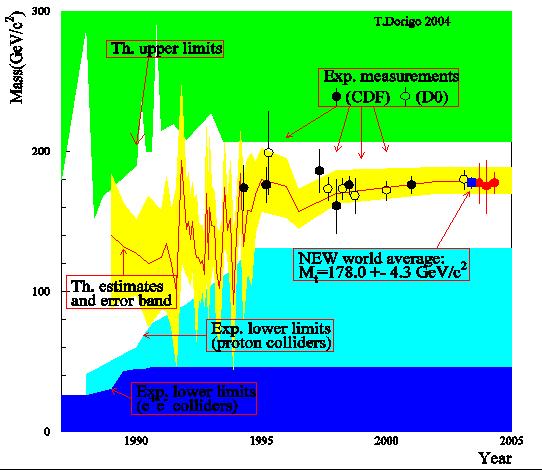Riccardo Barbieri (ETH Zurich) had a talk of the LEP era where he focused on some of the contributions of Altarelli to the derivation of Standard Model predictions for the masses of the top quark and the Higgs boson, both still unknown in the early nineties. His was a very nice and insightful presentation, but he at some point made a statement that surprised me, so I asked a question at the end of his talk.
The issue is one on which one could write a book - the interplay of theory and experiment and how each one influences the other. The statement that Barbieri made was that the indirect information from LEP - which was loosely pointing to a heavy top quark - had the effect of "speeding up" the decision of publishing the CDF top quark evidence, which was issued in April 1994.
First of all I need to mention that in 1994 there was already an experimental lower limit at 131 GeV on the mass of the top quark derived by direct searches. But the point is that inside CDF the researchers had a hunch of what the top mass was already in the mid of 1993, when a few very clean top pair candidates had finally emerged from the data (Run 1A collected data in 1992-93). And a "event structure" analysis which did not rely on the precise but taxing requirement of the presence of b-quark tags in the hadronic jets was showing that there was an excess of events not attributable to backgrounds, and pointed to a heavy top quark in the 180 GeV range.
So I made the following comment, which I report verbatim and only integrate with two explanatory sentences within brackets:
"Thank you for this very insightful presentation. Now I realize I am in the lions' lair for making the following comment, but I need to do it anyway. So, I was a bit surprised by your statement that the indirect fits had an influence in speeding up the first "top evidence" publication of CDF, which you quoted as being published in sept 1994 but which I remind was made public in April 1994, when Giorgio Belettini indeed came to this very auditorium to present the result. And incidentally, Altarelli in that occasion rose his hand to ask the question "What's Vecbos?" - [Monte Carlo tools to understand the dominant W+jets background were not so well known back then].
The reason I am surprised is that CDF had ended data taking from run 1A in 1993, and was definitely going to publish their search; it made no sense to slow down as the data from Run 1b only started to be collected in 1994 and in those days it took several months to go from raw data to analysis plots. People knew that there were candidates in the 170 GeV range already in Marseille, July 1993. And there was a kinematical analysis that had already a best fit in that mass region, but was being kept in stalemate by the CDF management."
The speaker did not comment on my comment, as of course there was little to object - those above are just facts that are well-known by those who lived through those exciting times.
Incidentally, I think it is useful to show a graph that displays the timeline of the search for the top quark in the eighties and nineties. Here, by comparing the lower limits on the top mass obtained by experimental searches with indirect limits by theoretical fits, one can observe that the latter followed the former, and not vice-versa! So Barbieri's argument could be turned by 180 degrees - but that would also be unfair, as indeed the theoretical progress on understanding radiative corrections in those years was impressive and proceeded at a very steady pace. It just happened that experiment and theory proceeded in synchrony for the top quark quest, and the strong coupling of the sensitivity of each is maybe the surprising bit in the whole story.

I realize the one above is a rather busy plot, but you can easily distinguish the experimental lower limits (in dark and light blue at the bottom), the indirect information (in green and yellow), and the direct measurements by CDF (black bullet) and DZERO (empty bullets). If you look closely, when CDF published its first result in 1994 (the leftmost black bullet) the experimental lower limits were just as constraining as the theoretical bounds, which had been growing with time in loose synchrony with the experimental bounds.





Comments